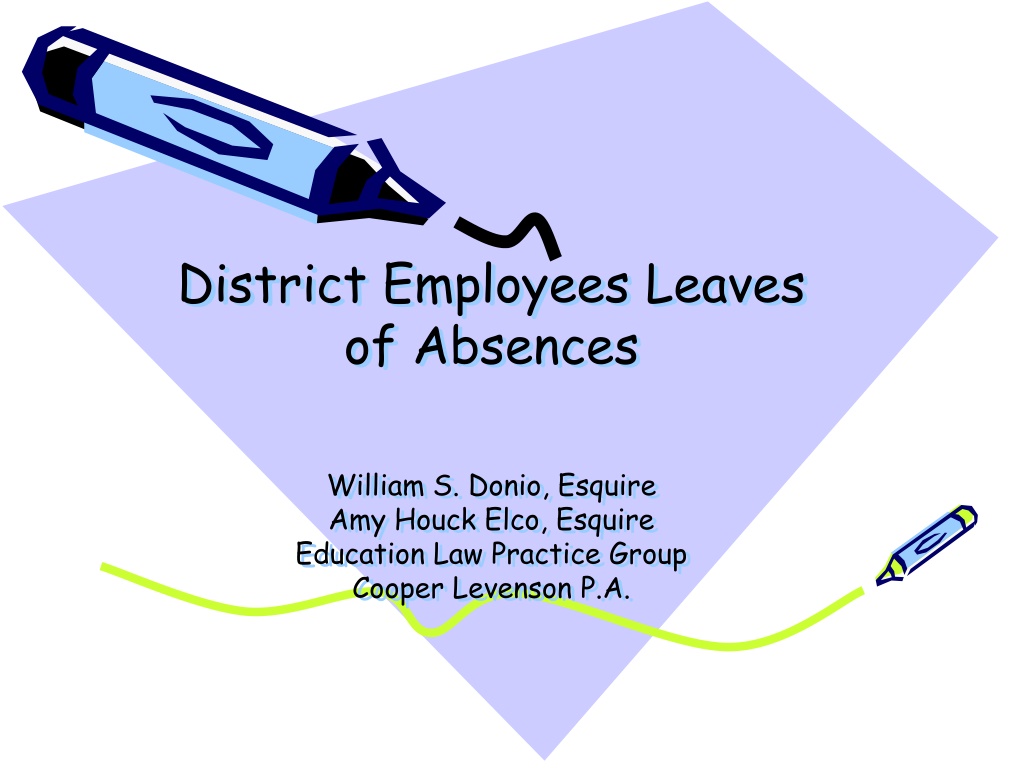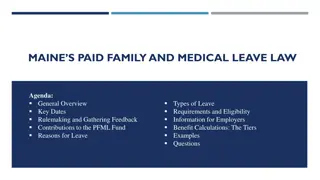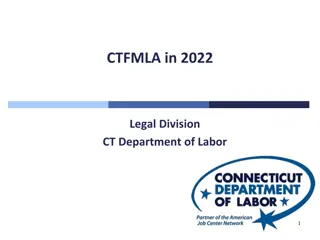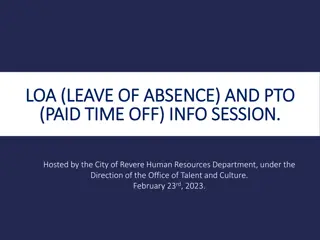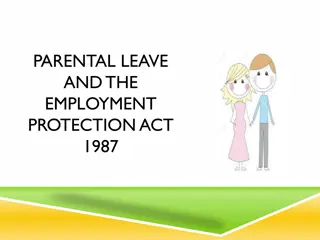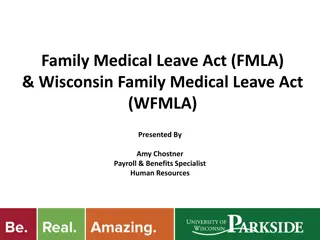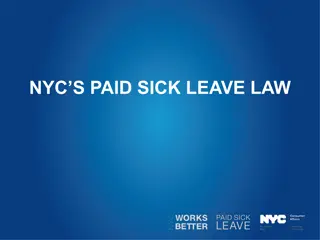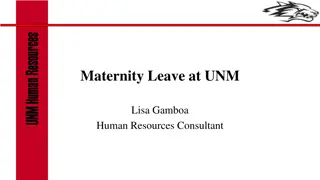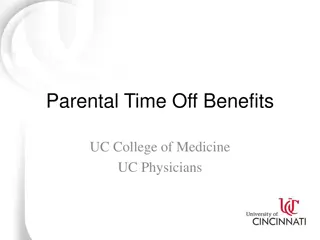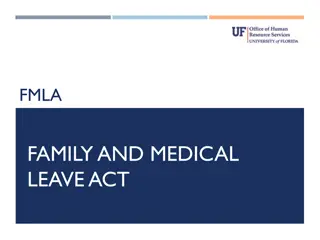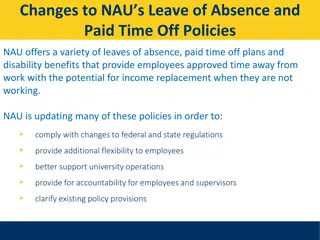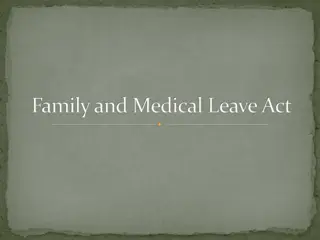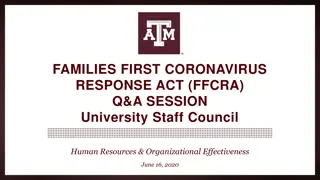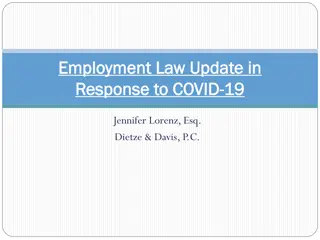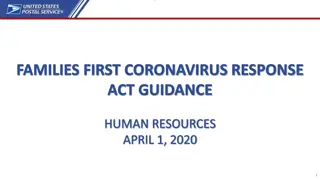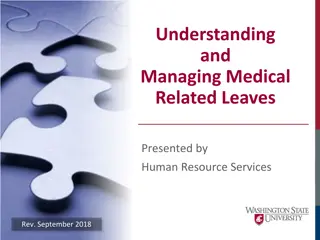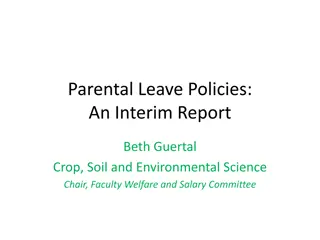Understanding Family Medical Leave Act (FMLA) and Covered Employers
FMLA entitles eligible employees to take unpaid, job-protected leave for family and medical reasons, such as caring for a newborn or a family member with a serious health condition. Covered employers, including public agencies, must provide FMLA benefits. The law offers important protections for employees facing qualifying situations like military caregiving or adoption. Employers, including schools, must comply with FMLA requirements, ensuring employees can take necessary leave without risking their job security or health insurance coverage.
Download Presentation

Please find below an Image/Link to download the presentation.
The content on the website is provided AS IS for your information and personal use only. It may not be sold, licensed, or shared on other websites without obtaining consent from the author. Download presentation by click this link. If you encounter any issues during the download, it is possible that the publisher has removed the file from their server.
E N D
Presentation Transcript
District Employees Leaves of Absences William S. Donio, Esquire Amy Houck Elco, Esquire Education Law Practice Group Cooper Levenson P.A.
Family Medical Leave Act (FMLA) Of 1993
FMLA Overview The FMLA entitles eligible employees of covered employers to take unpaid, job- protected leave for specified family and medical reasons with continuation of group health insurance coverage under the same terms and conditions as if the employee had not taken leave. Eligible employees are entitled to: Twelve work weeks of leave in a 12-month period for: the birth of a child and to care for the newborn child within one year of birth; the placement with the employee of a child for adoption or foster care and to care for the newly placed child within one year of placement; to care for the employee s spouse, child, or parent who has a serious health condition; a serious health condition that makes the employee unable to perform the essential functions of his or her job; any qualifying exigency arising out of the fact that the employee s spouse, son, daughter, or parent is a covered military member on covered active duty; or Twenty-six workweeks of leave during a single 12-month period to care for a covered service member with a serious injury or illness if the eligible employee is the service member s spouse, son, daughter, parent, or next of kin (military caregiver leave).
Covered Employers The FMLA applies only to covered employers. A covered employer may be a school. Covered employers must provide FMLA benefits and protections to eligible employees and comply with other responsibilities required under the FMLA and its regulations at 29 CFR Part 825.
Public Agency Public agencies are covered employers under the FMLA, regardless of the number of employees they employ. Public agencies include: The federal government, The government of a state or political subdivision of a state, and An agency of the United States, a state, or a political subdivision of a state, including counties, cities and towns, or any interstate governmental agency. The term state includes any state within the United States, the District of Columbia, and any territory or possession of the United States.
29 CFR Section 825.108 (a) An employer under FMLA includes any public agency, as defined in section 3(x) of the Fair Labor Standards Act, 29 U.S.C. 203(x). Section 3(x) of the FLSA defines public agency as the government of the United States; the government of a State or political subdivision of a State; or an agency of the United States, a State, or a political subdivision of a State, or any interstate governmental agency. State is further defined in Section 3(c) of the FLSA to include any State of the United States, the District of Columbia, or any Territory or possession of the United States. (b) The determination of whether an entity is a public agency, as distinguished from a private employer, is determined by whether the agency has taxing authority, or whether the chief administrative officer or board, etc., is elected by the voters-at-large or their appointment is subject to approval by an elected official. (c)(1) A State or a political subdivision of a State constitutes a single public agency and, therefore, a single employer for purposes of determining employee eligibility. For example, a State is a single employer; a county is a single employer; a city or town is a single employer. Whether two agencies of the same State or local government constitute the same public agency can only be determined on a case-by-case basis. One factor that would support a conclusion that two agencies are separate is whether they are treated separately for statistical purposes in the Census of Governments issued by the Bureau of the Census, U.S. Department of Commerce. (2) The Census Bureau takes a census of governments at five-year intervals. Volume I, Government Organization, contains the official counts of the number of State and local governments. It includes tabulations of governments by State, type of government, size, and county location. Also produced is a universe list of governmental units, classified according to type of government. Copies of Volume I, Government Organization, and subsequent volumes are available from the Superintendent of Documents, U.S. Government Printing Office, Washington, DC 20402, U.S. Department of Commerce District Offices, or can be found in Regional and selective depository libraries, or online at http://www.census.gov/govs/www/index.html. For a list of all depository libraries, write to the Government Printing Office, 710 N. Capitol St. NW., Washington, DC 20402. (d) All public agencies are covered by the FMLA regardless of the number of employees; they are not subject to the coverage threshold of 50 employees carried on the payroll each day for 20 or more weeks in a year. However, employees of public agencies must meet all of the requirements of eligibility, including the requirement that the employer (e.g., State) employ 50 employees at the worksite or within 75 miles.
Schools Local educational agencies are covered under the FMLA, regardless of the number of employees they employ. Such educational agencies include: Public school boards, Public elementary and secondary schools, and Private elementary and secondary schools.
Notice Requirements: Employer *Every employer covered by the FMLA must provide a general notice to their employees regarding the FMLA. To satisfy the general notice requirement, employers must (1) display or post a general notice (poster), and (2) if the employer has any FMLA eligible employees, provide a written general notice to employees. *Every employer covered by the FMLA must display or post an informative general notice about the FMLA. *The poster must be displayed in plain view where all employees and applicants can readily see it, and must have large enough text so it can be easily read. *The information displayed on the poster must explain the FMLA provisions and provide information on how to file a complaint with the Wage and Hour Division. *This poster must be displayed even if no employees are currently eligible for FMLA leave. *If a significant portion of an employer s employees do not read and write English, the employer must provide the General Notice in a language in which they can read and write.. When providing FMLA notices to sensory-impaired individuals, employers must also comply with all applicable requirements under federal and state law.
Notice Requirements: Employer Continued Employers may make the poster available electronically, create their own poster, or use another format, as long as the information provided includes, at a minimum, all the information contained in the Federal Department of Labor s FMLA Poster, is viewable by applicants for employment and current employees, and meets all other posting requirements. Providing General Notice to Employees In addition to displaying a poster, if a covered employer has any FMLA eligible employees, it must also provide each employee with a general notice about the FMLA in the employer s employee handbook, School Board Policies, or other written materials about leave and benefits. If no handbook or written leave materials exist, the employer must distribute this general notice to each new employee upon hire.
Notice Requirements: Employee Employees must provide notice of their need for FMLA leave. In general, an employer may require that employees comply with the employer s usual and customary policies for requesting leave, unless unusual circumstances prevent the employee from doing so. The employer can take action under its internal policies and procedures if the employee fails to follow its usual and customary rules for requesting leave. Employers may not, however, discriminate against employees taking FMLA leave. An employer may also choose to waive the employee s notice requirement or its own internal policies about leave requests.
Notice Requirements: Contents of Employee Notice An employee s notice of a need for FMLA leave may be oral or written. The first time the employee requests leave for a qualifying reason, he or she is not required to specifically mention the FMLA. However, the employee is required to provide enough information for the employer to know that the leave may be covered by the FMLA. For foreseeable leave, the employee must also indicate when and how much leave is needed. Once approved for a particular FMLA leave reason, if additional leave is needed for that same reason, the employee may be required to reference that reason or the FMLA. In all cases, the employer may ask additional questions to determine if the leave is FMLA-qualifying.
Notice Requirements: Employees Timing-Foreseeable Generally, an employee must give at least 30 days advance notice of the need to take FMLA leave when he or she knows about the need for the leave in advance and it is possible and practical to do so. If 30 days advance notice is not possible because the foreseeable situation has changed or the employee does not know exactly when leave will be required, the employee must provide notice of the need for leave as soon as possible and practical. In the case of FMLA leave for a qualifying exigency of a military family member, the employee must give notice of the need for such leave as soon as possible and practical, regardless of how far in advance the leave is needed. For planned medical treatment, the employee must consult with his or her employer and try to schedule the treatment at a time that minimizes the disruption to company operations. The employee should consult with the employer prior to scheduling the treatment in order to arrange a schedule that best suits the needs of both the employee and employer.
Notice Requirements: Employees Timing-Unforeseeable When the need for leave is unexpected, the employee must provide notice as soon as possible and practical. It should usually be reasonable for the employee to provide notice of leave that is unforeseeable within the time required by the employer s usual and customary notice requirements. Whether the employee s notice of unforeseeable leave is timely will depend upon the facts of the particular case.
Whats Next As soon as an employer has enough information that indicates an employee s need for leave may be for an FMLA-qualifying reason, the employer should begin the FMLA leave process. Superintendents, Business Administrators, Principals, and Human Resources administrators must be able to recognize FMLA- qualifying reasons for leave and properly initiate the required notifications and eligibility checks. You are responsible!
Eligible Employees An eligible employee is one who: Works for a covered employer, Has worked for the employer for at least 12 months as of the date the FMLA leave is to start, Has at least 1,250 hours of service for the employer during the 12-month period immediately before the date the FMLA leave is to start. 12 Months of Employment The 12 months of employment do not have to be consecutive: Part-time, temporary, or seasonal work generally counts towards the 12 months of employment; If an employee is maintained on the payroll for any part of a week, that week counts as a week of employment; Any combination of 52 weeks equals 12 months, and If the employee has a break in employment that lasted seven years or more, the employer is not required to count the time worked prior to the break, unless: The break in employment is due to service covered by the Uniformed Services Employment and Reemployment Rights Act (USERRA), or There is a written agreement, including a collective bargaining agreement, outlining the employer s intention to rehire the employee after the break in employment; An employer may voluntarily consider periods of employment prior to a break of more than seven years, but it must do so uniformly for all employees with similar breaks in employment.
1,250 Hours of Service The hours of service requirement will be met if an employee has worked a total of 1,250 hours of service in the 12 months immediately preceding the start of the FMLA leave. This averages to a little more than 24 hours of work a week in the 12-month period. Generally, the principles for compensable hours of work under the Fair Labor Standards Act (FLSA) are used in determining the hours of service that an employee has worked. Only the time actually worked, including overtime hours worked, is counted. Time not actually worked, including vacation, personal leave, sick leave, holidays, and any other form of paid time off (PTO) is not counted towards the 1,250 hours of service. Unpaid leave of any kind or periods of layoff also are not counted. Time worked as a part-time, temporary, or seasonal employee counts toward the requirement. An employee returning from fulfilling a USERRA-covered military service obligation is credited with the hours of service that would have been performed but for the period of military service. The employee s pre- service work schedule can generally be used for calculations to determine hours that would have been worked during the period of military service. If an employer does not maintain accurate time records of hours worked by an employee, the employer has the burden of showing that the employee has not met the hours of service requirement.
Schools Employees & Hours Worked Requirements Although public agencies and elementary and secondary schools are covered employers without regard to the number of employees they employ, public agency and school employees must still meet FMLA eligibility requirements. This means that an eligible employee of a public agency or school is one who: Will have worked for the employer for at least 12 months as of the date the FMLA leave is to start, Will have at least 1,250 hours of service for the employer during the 12- month period immediately before the date the FMLA leave is to start, and Works at a location where the employer employs at least 50 employees within 75 miles as of the date when the employee gives notice of the need for leave. Generally, a public agency is treated as a single employer for purposes of determining employee eligibility.
Employer Duty to Give Employee Notice of Eligibility After an employer has determined an employee s FMLA eligibility status, the employer must: Provide an Eligibility Notice to the employee, either orally or in writing, informing the employee whether he or she is eligible for FMLA leave; If the employer determines that the employee is not eligible for FMLA leave, it must state at least one reason why the employee is not eligible. Provide the Eligibility Notice to the employee within five business days of the initial request for leave or of learning that an employee s leave may be for an FMLA-qualifying reason, unless there are extenuating circumstances; Provide the Eligibility Notice the first time the employee takes leave for an FMLA-qualifying reason in the designated 12-month leave year, and If a significant portion of the employer s workforce is not literate in English, provide the Eligibility Notice in a language in which employees are literate. Employers are not required to provide a new Eligibility Notice for: FMLA absences for the same qualifying reason during the same leave year, or FMLA absences for a different qualifying reason where the employee s eligibility status has not changed.
Caution You could be exposing yourself to liability by failing to make a timely eligibility determination or failing to provide timely notice to your employees. Failure to timely notify employees of their eligibility status may constitute interference with, restraint, or denial of the exercise of an employee's FMLA rights.
Rights and Responsibility Notice Employers must provide a written Rights and Responsibilities Notice each time the employer provides an eligible employee the Eligibility Notice, within five business days of having notice of the employee s need for leave. If the employee s leave has already begun, the Rights and Responsibilities Notice should be mailed to the employee s address of record. The Rights and Responsibilities Notice details the specific expectations and obligations of the employee relating to his or her FMLA leave. Employers are expected to be responsive in answering questions from employees concerning their rights and responsibilities under the FMLA. If a significant portion of an employer s workforce is not literate in English, the Rights and Responsibilities Notice must be provided in a language in which employees are literate.
Contents Rights & Responsibility Notice- Can be electronic The Rights and Responsibilities Notice must be in writing and must include all of the following information, as appropriate: A statement of the period of leave that may be designated and counted against the employee s FMLA leave entitlement, The 12-month period used to track FMLA leave usage, Whether the employee will be required to provide certification of the need for leave, The employee s right to use paid leave, whether the employer will require the substitution of paid leave, any conditions related to the substitution, and the employee s right to take unpaid FMLA leave if the employee does not meet the conditions for paid leave; The employee s status as a key employee and potential restoration consequences, if applicable; A key employee is a salaried FMLA-eligible employee who is among the highest paid 10% of all employees, both eligible and ineligible, within 75 miles of the worksite. The employee s right to job restoration and maintenance of benefits, Whether the employee will be required to make premium payments to maintain health benefits and any arrangements for doing so, the consequences of failing to make payments on a timely basis, and the employee s potential liability for premium payments made by the employer if the employee fails to return to work; and The consequences of failing to meet his or her obligations. If information provided in the Rights and Responsibilities Notice changes, the employer must inform the employee of the changes, in writing, within five business days of the first time subsequent to the changes that the employee gives notice of need for leave.
Qualifying Reasons for FMLA Eligible employees may take up to 12 workweeks of FMLA leave in a 12- month period for the following qualifying reasons: The birth of a child and to bond with the newborn child within one year of birth, The placement with the employee of a child for adoption or foster care and to bond with the newly-placed child within one year of placement, A serious health condition that makes the employee unable to perform the functions of his or her job, including incapacity due to pregnancy and for prenatal medical care, To care for the employee s spouse, son, daughter, or parent who has a serious health condition, including incapacity due to pregnancy and for prenatal medical care; Any qualifying exigency arising out of the fact that the employee s spouse, son, daughter, or parent is a military member on covered active duty or call to covered active duty status.
Military Care Giver Leave In addition, eligible employees may take up to 26 workweeks of leave in a single 12-month period to care for a covered service member with a serious injury or illness if the employee is the spouse, son, daughter, parent, or next of kin of the service member. An eligible employee is limited to a combined total of 26 workweeks of leave for any FMLA-qualifying reasons during the single 12-month period.
Immediate Family Member Employees can take FMLA leave due to a serious health condition of the following immediate family members: Spouse / Parent /Son or Daughter Spouse Spouse means a husband or wife as defined or recognized in the state where the individual was married, including in a common law marriage or same-sex marriage. Spouse also includes a husband or wife in a marriage that was validly entered into outside of the United States, if the marriage could have been entered into in at least one state. Parent Parent means a biological, adoptive, step or foster father or mother, or any other individual who stood in loco parentis to the employee when the employee was a child. This term does not include parents-in-law. Son or daughter Son or daughter means a biological, adopted, or foster child, a stepchild, a legal ward, or a child of a person standing in loco parentis, who is under 18 years of age or who is 18 years of age or older and incapable of self-care because of a mental or physical disability at the time that FMLA leave is to commence. The onset of a disability may occur at any age for purposes of the definition of an adult son or daughter under the FMLA.
Birth or Adoption Counseling sessions, appearances in Court, and requisite physical examinations relating to the adoption/placement may also be covered. Leave must be concluded within 12 months of the birth or adoption
What Does it Mean to Care for An employee must actually be involved in the relative s care. This would be an inclusion in the physical and psychological care of the family member. Assistance with routine daily hygiene, medical decision-making, safety, nutritional care and psychological comfort. Almost Anything???
What About Child Over 18? In order for a parent to take FMLA leave for a child who is 18 or over, the son or daughter must: Have a disability as defined by the Americans with Disabilities Act (ADA) at the time the leave is to commence, Be incapable of self-care because of the disability, Have a serious health condition, and Need care because of the serious health condition.
In Loco Parentis An individual stands in loco parentis to a child if he or she has day- to-day responsibilities to care for or financially support the child. The person standing in loco parentis is not required to have a biological or legal relationship with the child. Although no legal or biological relationship is necessary, grandparents or other relatives, such as siblings, may stand in loco parentis to a child under the FMLA where all other requirements are met. The in loco parentis relationship exists when an individual intends to take on the role of a parent. Similarly, an individual may have stood in loco parentis to an employee when the employee was a child even if the individual has no legal or biological relationship to the employee.
Documenting the Family Relationship An employer may, but is not required to, request that an employee provide reasonable documentation of the qualifying family relationship. An employee may satisfy this requirement by providing either a simple statement asserting that the requisite family relationship exists, or other documentation such as a child s birth certificate or a court document. It is the employee s choice whether to provide a simple statement or other documentation. Employers may not use a request for confirmation of a family relationship in a manner that interferes with an employee s exercise or attempt to exercise his or her FMLA rights.
Serious Health Condition A serious health condition is an illness, injury, impairment, or physical or mental condition that involves inpatient care or continuing treatment by a health care provider. The FMLA does not apply to routine medical examinations, such as a physical, or to common medical conditions, such as an upset stomach, unless complications develop. For all conditions incapacity means inability to work, including being unable to perform any one of the essential functions of the employee s position, or inability to attend school, or perform other regular daily activities due to the serious health condition, treatment of the serious health condition, or recovery from the serious health condition. The term treatment includes but is not limited to examinations to determine if a serious health condition exists and evaluations of the condition.
Some Examples of Serious Health Conditions Provided by Congress Heart attacks or conditions requiring operations; Cancer; Back conditions requiring extensive therapy or surgery; Strokes Severe Respiratory Conditions Spinal Injuries Appendicitis Pneumonia Emphysema Severe Arthritis Severe Nervous Disorders Injuries Cased by Serious Accidents Pregnancy Complications: Miscarriage, Severe Morning Sickness, Childbirth
Inpatient Care An overnight stay in a hospital, hospice, or residential medical care facility. Includes any period of incapacity or any subsequent treatment in connection with the overnight stay
Continuing Care by a Health Care Provider Incapacity Plus Treatment A period of incapacity of more than three consecutive, full calendar days, and any subsequent treatment or period of incapacity relating to the same condition, that also involves: Two or more in-person visits to a health care provider for treatment within 30 days of the first day of incapacity unless extenuating circumstances exist. The first visit must be within seven days of the first day of incapacity; or, At least one in-person visit to a health care provider for treatment within seven days of the first day of incapacity, which results in a regimen of continuing treatment under the supervision of the health care provider. For example, the health provider might prescribe a course of prescription medication or therapy requiring special equipment. Pregnancy Any period of incapacity due to pregnancy or prenatal care Chronic Conditions Any period of incapacity due to or treatment for a chronic serious health condition, such as diabetes, asthma, migraine headaches. A chronic serious health condition is one which requires visits to a health care provider (or nurse supervised by the provider) at least twice a year and recurs over an extended period of time. A chronic condition may cause episodic rather than a continuing period of incapacity.
Continuing Care by a Health Care Provider Permanent or Long-term Conditions A period of incapacity which is permanent or long-term due to a condition for which treatment may not be effective, but which requires the continuing supervision of a health care provider, such as Alzheimer s disease or the terminal stages of cancer. Conditions Requiring Multiple Treatments Restorative surgery after an accident or other injury; or, A condition that would likely result in a period of incapacity of more than three consecutive, full calendar days if the employee or employee s family member did not receive the treatment If an eligible employee requests FMLA leave for surgery which requires and/or results in an overnight stay in the hospital, the leave request would meet the definition of a serious health condition under the inpatient care criteria, even if the surgery is considered elective.
Certification In certain circumstances, an employer may require that an employee submit a certification to support the employee s need for FMLA leave. The certification is a document or form that is completed by the employee and, as appropriate, a health care provider. The certification will allow the employer to: Obtain information related to the FMLA leave request, including the likely periods of absences; and Verify that an employee, or the employee s ill family member, has a serious health condition (or, in the case of military family leave, that facts exist to support the employee s request for such leave). The employee has the responsibility to provide the initial certification if his or her employer requests it. This includes the responsibility, when applicable, to find a health care provider to provide a complete and sufficient certification, and to pay for the cost of the initial certification. If the employee does not provide the certification, the employer may deny the employee s request for FMLA leave.
When Can You Require Certification? An employer may require a certification when an employee requests leave for: The employee s own serious health condition, An employer may also, in certain circumstances, require a fitness-for-duty certification at the conclusion of the employee s leave as a condition to returning the employee to the job. The serious health condition of the employee s parent, spouse, son or daughter, and Military family leave Employers may not request a certification for leave to bond with a healthy newborn child or a child placed for adoption or foster care. However, employers may request documentation to confirm the family relationship
Health Care Providers & Certification If an employer requires a medical certification, part of it must be completed by a health care provider, which is defined as: A doctor of medicine or osteopathy authorized to practice medicine or surgery by the state in which the doctor practices, A podiatrist, dentist, clinical psychologist, optometrist, or chiropractor (with limitations) authorized to practice in the state and performing within the scope of his or her practice; A nurse practitioner, nurse-midwife, clinical social worker, or physician assistant authorized to practice in the state and performing within the scope of his or her practice; Any health care provider from whom the employer or the employer s group health plan s benefits manager will accept a medical certification to substantiate a claim for benefits.
Certification Notice & Timing Employers must notify employees each time they require a medical certification. The employer s notice that a certification is required must be included in the written Rights and Responsibilities Notice that the employer gives the employee within five business days of becoming aware of the employee s need for FMLA leave. In some instances, an employer may request a medical certification at a later date if the employer has reason to question the appropriateness of the leave or its duration. When requesting a medical certification, the employer must advise the employee of the consequences of failing to provide a complete and sufficient certification.
Certification Notice & Timing Continued The employee must provide the requested medical certification within 15 calendar days after an employer s request, unless it is not feasible under the particular circumstances to do so despite the employee s good faith efforts, or if the employer permits more than 15 calendar days to return the requested certification. When an employee makes diligent good faith efforts but is unable to meet the 15- calendar day deadline, the employee is entitled to additional time to provide the certification. If an employee fails to return the certification in a timely manner, the employer can deny FMLA protections for the leave following the expiration of the 15-calendar day time period until a complete and sufficient certification is provided. However, the 15- day period and the period of absence beginning the day the certification was received is FMLA-protected leave. If an employee fails to provide a certification within 15 calendar days from receipt of the request for certification but made diligent, good faith efforts to do so and the delay was due to extenuating circumstances outside his or her control, the employer may not deny the leave for the period that the certification was late. In all cases, if the employee never produces the certification, the leave is not FMLA- protected leave.
Complete & Sufficient Medical Certification The medical facts appropriate for inclusion on the certification form will vary depending on the nature of the serious health condition and are to be determined by the health care provider but must be sufficient to support the need for leave. The information requested may relate only to the serious health condition for which the employee is seeking leave. A complete and sufficient certification need only include the following information: Contact information for the health care provider, including name, address, telephone number, fax number, and type of medical practice / specialty; When the serious health condition began, How long the serious health condition is expected to last, If the employee is the patient, whether the employee is unable to work, and the likely duration of this inability; If a family member is the patient, whether the family member needs care, and an estimate of the frequency and duration of the leave required to care for the family member; Whether the employee s need for leave is continuous or intermittent, and Appropriate medical facts about the condition. Appropriate Medical Facts At the health care provider s discretion, the medical facts may include information on symptoms, doctor s visits, or a diagnosis. Whether a diagnosis is included in the certification form is left to the discretion of the health care provider and an employer may not reject a complete and sufficient certification because it lacks a diagnosis.
Intermittent or Reduced Schedule Leave Treatment for the Employee s Own or Family Member s Serious Health Condition Information that establishes the medical necessity of intermittent or reduced schedule leave An estimate of the dates and duration of such treatment and periods of recovery Unforeseeable Leave for the Employee s Own Serious Health Condition, Pregnancy Information that establishes the medical necessity of intermittent or reduced schedule leave An estimate of the frequency and duration of the episodes of incapacity due to the serious health condition Unforeseeable Leave for the Family Member s Serious Health Condition A statement that the leave schedule is medically necessary for the care of the family member, which can include assisting in the family member s recovery An estimate of the frequency and duration of leave The FMLA does not permit an employer to require an exact schedule of leave for such instances.
Must Accept Any Format Certification The employer must accept a complete and sufficient medical certification, regardless of the format. The employer cannot reject a medical certification that contains all the information needed to determine if the leave is FMLA- qualifying. The employer cannot refuse: A fax or copy of the medical certification, A medical certification that is not completed on the employer s standard company form, or Any other record of the medical documentation, such as a communication on the letterhead of the health care provider.
If you find certification incomplete, you must: Give the employee a written notice stating what additional information is necessary to make the certification complete and sufficient. The employer may use the designation notice to inform the employee that the certification is incomplete or insufficient and identify what information is needed to make the certification complete and sufficient. A certification is considered incomplete if one or more applicable entries have not been completed. A certification is considered insufficient if the information provided is vague, ambiguous, or non-responsive. The employer must provide the employee with at least seven calendar days to correct any deficiency in the certification. If it is not practicable under the particular circumstances for the employee to cure any deficiency in the seven-day period despite the employee s diligent good faith efforts, the employer should provide additional time. If an employee fails to provide a complete and sufficient certification despite the opportunity to cure the deficiency, an employer may deny the employee s request for FMLA leave. If you have gotten a complete Certification, you CANNOT ask for more information
Authentication & Clarification After the employer has given the employee the opportunity to cure any deficiencies, the employer may contact the health care provider only for purposes of authentication and/or clarification of the medical certification. Under no circumstances may the employee s direct supervisor contact the employee s health care provider. A human resources professional, a leave administrator, or a management official must make the contact. ((Change)) Authentication means providing the health care provider with a copy of the certification and confirming that the information contained on the certification form was completed and/or authorized by the health care provider who signed the document. Clarification means contacting the health care provider to understand the handwriting on the medical certification or to understand the meaning of a response. An employer may not ask health care providers for additional information beyond that in the certification form. The requirements of the Health Insurance Portability and Accountability Act (HIPAA) Privacy Rule govern the privacy of individually-identifiable health information created or held by HIPAA-covered entities. Therefore, HIPAA requirements must be satisfied for a HIPAA-covered entity to share an employee s or an employee s family member s individually-identifiable health information with an employer. HIPAA requires, among other things, a written authorization by the employee (or the employee s family member) in order to release information for clarification purposes. An employee may choose to authorize his or her health care provider to provide clarification directly to the employer; however, the employee may not be required to do so. If the employee chooses not to provide such authorization and does not otherwise clarify the certification, the employer may deny the FMLA leave request if the certification is unclear. It is the employee s responsibility to provide the employer with a complete and sufficient certification and to clarify the certification if necessary.
Second & Third Opinions If an employer has received a complete and sufficient certification but has a reason to doubt that it is valid, the employer may require the employee to obtain a second opinion at the employer s expense. The employer can choose the health care provider to provide the second opinion, but generally may not select a health care provider who it employs on a regular or routine basis. If the first and second opinions reach different conclusions, the employer may require a third opinion at the employer s expense. The third health care provider must be approved by both the employer and the employee. The opinion of the third health care provider is final. While waiting for the second (or third) opinion, the employee is provisionally entitled to FMLA leave, including the right to maintain his or her group health benefits. If the certifications do not ultimately establish that the employee is entitled to FMLA leave, the leave is not considered FMLA leave and may be treated as paid or unpaid leave under the employer s established leave policy. If the employee requests it, the employer must provide copies of second or third opinions within five business days absent extenuating circumstances. If a second or third opinion health care provider requests information relevant to the serious health condition at issue from the employee s or his or her family member s health care provider, and the employee or their family member does not authorize their health care provider to release such information, the FMLA leave may be denied. Under certain circumstances may ask for recertification after 30 days.
Recertification for Leaves Less than 30 days & More than 1 year An employer may request a recertification in connection with an absence by the employee in less than 30 days only if: The employee requests an extension of leave, The circumstances described by the previous certification have changed significantly, or The employer receives information that casts doubt on the employee s stated reason for the absence or the continuing validity of the existing medical certification. In general, an employer may ask for the same information in a recertification as that permitted in the initial medical certification. As with the initial certification, in most circumstances, the employee has 15 calendar days after the employer s request to provide a complete and sufficient recertification. The employee is responsible for paying for the cost of a recertification. During recertification an employer may provide the health care provider with a record of the employee s absence pattern, such as an attendance record of FMLA leave use, and ask the health care provider if the serious health condition and need for leave is consistent with the absence pattern provided. Annual Medical Certification Where the need for leave for an employee s or family member s serious health condition lasts beyond a single leave year, the employer may require a new certification in each subsequent FMLA leave year. That means the employer may request a new medical certification with the first absence in a new 12-month leave year. Because it is a new certification and not a recertification, an employer may seek second and third opinions for these new medical certifications, as well as authenticate or clarify the certification with the health care provider.
Designation Notice The employer is responsible in all circumstances for designating leave as FMLA-qualifying and giving a Designation Notice to the employee. The Designation Notice informs the employee that the requested leave will be designated as FMLA leave and sets out the requirements applicable while the employee is on leave.
Designation Notice Continued The determination of whether leave is FMLA-qualifying must be based only on information received from the employee or the employee s spokesperson. If the employer does not have enough information to determine whether an employee s reason for leave qualifies for FMLA protections, the employer may ask the employee or his or her spokesperson to provide more information about the reason for leave. If an employer is unable to determine whether a leave request should be designated as FMLA-protected because a submitted certification is incomplete or insufficient, the employer is required to state in writing what additional information is needed. The employer may use the Designation Notice to inform the employee that the certification is incomplete or insufficient and identify what information is needed to make the certification complete and sufficient. for more information on the certification process. Once the employer has enough information to determine that the employee s requested leave qualifies as FMLA leave, the employer must provide the employee with a written Designation Notice within no more than five business days, absent extenuating circumstances. If the leave does not qualify as FMLA leave, the employer must notify the employee in writing that the leave is not FMLA- protected. Such notice can be a simple written statement. The employer needs to provide the employee with only one Designation Notice for each FMLA- qualifying reason for leave in the 12-month leave year, regardless of whether the leave is taken in a continuous block or intermittently or on a reduced schedule. If the employee requests leave and the information provided in the Designation Notice changes, the employer must provide the employee written notice of the change within five business days of receiving the employee s leave request subsequent to any change. Although a medical certification will often provide the information needed to determine that the leave is FMLA-qualifying, if the employer has enough information to designate the leave as FMLA leave immediately after receiving the notice of the need for leave, the employer may provide the employee with the Designation Notice at that time. Failure to provide a timely Designation Notice to an employee may be considered interference with, restraint, or denial of the exercise of the employee's FMLA rights.
Contents of Designation Notice In addition to designating leave as FMLA qualifying, the written Designation Notice must include all of the following: The amount of leave that will count against the employee s FMLA leave entitlement, if known; If the exact amount of leave is not known at the time of the designation the employer must provide this information in writing upon the employee s request, but no more often than once in a 30- day period and only if leave was taken. Whether the employee is required to substitute paid leave for unpaid FMLA leave, and Whether the employee will be required to submit a fitness-for-duty certification to return to work.
Paid Leave Concurrent Leave Negotiate? Case law says so.
